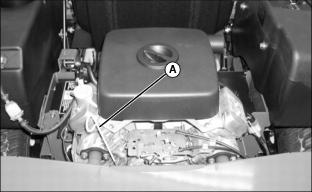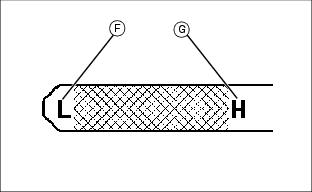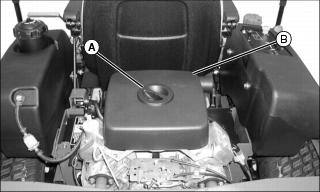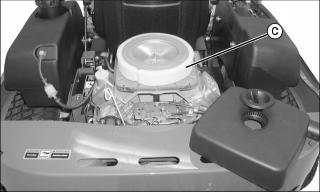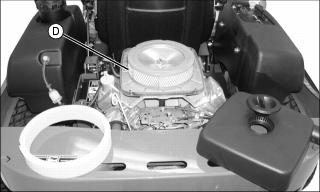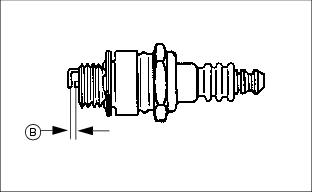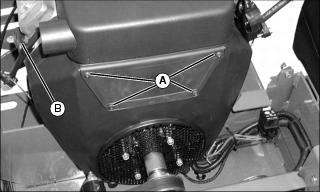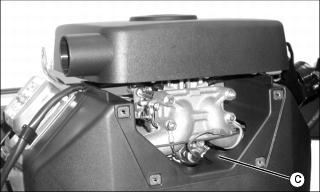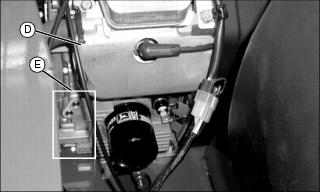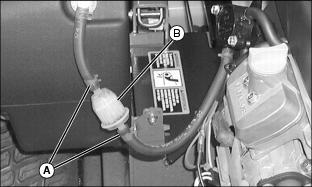Introduction
Product Identification
Safety
Operating
Replacement Parts
Service Intervals
Service Lubrication
Service Engine
Engine Warranty Maintenance Statement
Changing Engine Oil and Filter
Cleaning Air Intake Screen and Pump Drive Belt Compartment
Checking and Cleaning Air Filter Elements
Cleaning Engine Oil Cooling Fins (Model 757)
Service Transmission
Service Steering & Brakes
Service Mower
Service Electrical
Service Miscellaneous
Troubleshooting
Storage
Assembly
Specifications
Warranty
John Deere Quality Statement
Service Record

Service Engine
Engine Warranty Maintenance Statement
Maintenance, repair, or replacement of the emission control devices and systems on this engine, which are being done at the customers expense, may be performed by any non-road engine repair establishment or individual. Warranty repairs must be performed by an authorized John Deere dealer.
Avoid Fumes
Engine Oil
Use oil viscosity based on the expected air temperature range during the period between oil changes.
The following oils are preferred:
The following oils are also recommended, based on their specified temperature range:
Other oils may be used if above John Deere oils are not available, provided they meet one of the following specifications:
· API Service Classification SF, SG, SH or SJ
Checking Engine Oil Level
NOTE: Check oil twice a day if you run engine over 4 hours in a day.
Make sure engine is cold when checking engine oil level.
1. Park machine safely. (See Parking Safely in the Safety Section).
3. Clean area around dipstick prior to removing it.
4. Remove dipstick (A). Wipe it clean.
6. Remove dipstick and check oil level. Oil level should be between "low" (B) and "high" (C) marks on dipstick.
· If oil is low, add oil to bring oil level no higher than the "H" high mark on dipstick.
· If oil level is above the "H" high mark, drain to proper level.
IMPORTANT: Avoid damage! To prevent extensive engine wear or damage, always maintain the proper engine oil level. Never operate the engine with the oil level below the add mark or over the full mark. |
Changing Engine Oil and Filter
IMPORTANT: Avoid damage! Change the oil more often if the vehicle is used in extreme conditions: |
2. Park machine safely. (See Parking Safely in the Safety section).
3. Put container under drain tube (C).
5. Allow oil to drain into an oil drain pan.
6. After oil drains, close drain valve.
7. Remove oil filter (A). Turn filter counter-clockwise to remove.
8. Apply a film of clean engine oil on gasket of new filter.
9. Install filter. Turn filter clockwise until gasket makes contact with mounting surface. Tighten 1/2 to 3/4 turn after gasket contact.
10. Clean area around the oil fill cap (D) and oil dipstick (E).
11. Unscrew and remove the oil fill cap.
12. Add approximately 1.4 L (1.5 qt) of oil.
13. Install and tighten oil fill cap.
14. Start engine and run at slow throttle for approximately two minutes. Check for leaks around filter and drain plug.
· Remove and wipe oil dipstick clean with a rag.
· Remove dipstick and check oil level. Oil level must be between the "low" (F) and "high" (G) marks on dipstick. Add oil if needed.
Cleaning Air Intake Screen and Pump Drive Belt Compartment
IMPORTANT: Avoid damage! An obstructed air intake screen can cause engine damage due to overheating. Keep the air intake screen area and other external surfaces of the engine clean at all times. |
1. Park machine safely. (See Parking Safely in the Safety section.)
2. Lift and secure operator seat in the raised position.
3. Remove grass and debris from pump drive belt compartment (B).
4. Clean air intake screen (A) with a rag brush or compressed air.
Cleaning Engine Blower Fan
1. Park machine safely. (See Parking Safely in the Safety section.)
2. Lift and secure operator seat in the raised position.
3. Remove four screws securing air intake screen (A).
4. Clean blower fan with a rag, brush or compressed air.
5. Replace air intake screen and install four screws to secure it to engine.
Checking and Cleaning Air Filter Elements
NOTE: It may be necessary to check the air filter more frequently if operating vehicle in dusty conditions.
1. Park machine safely. (See Parking Safely in the Safety section.
2. Loosen air cleaner cover retaining knob (A) and remove the cover (B).
3. Inspect foam precleaner (C) without removing.
4. If foam precleaner is dirty, carefully remove from filter, leaving paper element (D) in the air cleaner housing:
· Wash foam precleaner in a solution of warm water and liquid detergent. Squeeze out excess water in a dry cloth until precleaner is completely dry. (Do not wring.)
5. Inspect and replace paper filter element only if damaged or very dirty.
6. Remove element cover wing nut (E) and cover (F) and remove paper element.
7. Install cleaned foam precleaner and new paper element.
8. Install element cover and wing nut.
9. Install air cleaner cover and retaining knob.
Checking Spark Plugs
1. Park machine safely. (See Parking Safely in the Safety section.)
2. Clean area around both spark plugs.
3. Disconnect the spark plug wire (A) from each plug.
4. Remove and inspect spark plugs:
· Clean each plug and check for damage, replace if necessary.
· If plugs are in good condition, check gap.
5. Check and adjust spark plug gap (B) to 0.75 mm (0.030 in.).
· Tighten to 22 N·m (16 ft-lb).
7. Install both spark plug wires.
Cleaning Engine Oil Cooling Fins (Model 757)
1. Park machine safely. (See Parking Safely in the Safety section.)
2. Locate engine oil cooler on right side of the engine.
4. Clean engine oil cooling fins (A) with a rag, brush, or compressed air.
Cleaning Engine Cooling Fins
1. Park machine safely. (See Parking Safely in the Safety section.)
2. Lift and secure operator seat in the raised position.
3. Remove four screws (A) holding shroud to engine.
4. Remove spark plug wire (B) from each engine spark plug.
5. With compressed air, thoroughly clean grass buildup and debris from the following areas:
· Head cooling passage behind engine shroud (C).
· Remove shrouds (D) on both sides of engine to clean behind each spark plug access hole.
· Area (E) on the right side of the engine.
· Area (F) on the rear and left sides of the engine.
Adjusting Carburetor
NOTE: Carburetor is calibrated by the engine manufacturer and is not adjustable.
If engine is operated at altitudes above 1829 m (6,000 ft), some carburetors may require a special high altitude main jet. See your John Deere dealer.
If engine is hard to start or runs rough, check the troubleshooting section of this manual.
Possible engine surging will occur at high throttle with transmission in "N" neutral and mower engagement lever disengaged. This is a normal condition due to the emission control system.
After performing the checks in the troubleshooting section and your engine is still not performing correctly, contact your John Deere dealer.
Replacing Fuel Filter
IMPORTANT: Avoid damage! When installing a new fuel filter, the filter arrow must be pointed in the direction of the fuel flow. |
NOTE: Change filter when fuel is low.
1. Park machine safely. (See Parking Safely in the Safety section).
3. Slide hose clamps (A) away from fuel filter (B).
4. Place a drain pan under hoses to catch any fuel that may be left in the hoses.
5. Disconnect hoses from fuel filter.
· Make sure fuel filter is installed with arrow pointing in direction of fuel flow.


